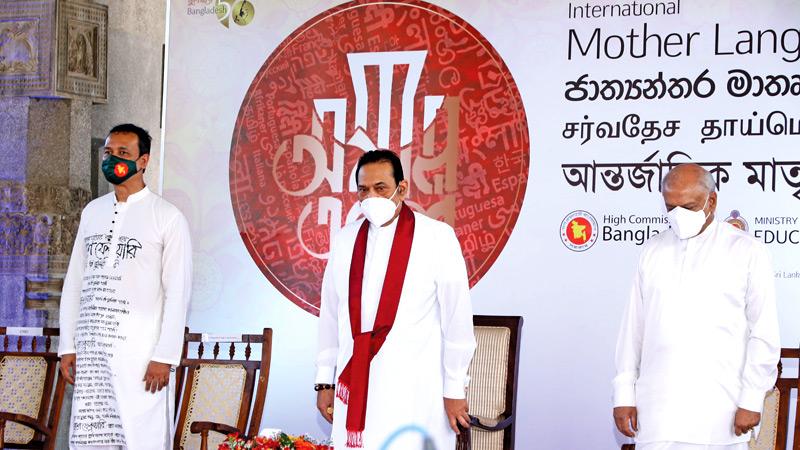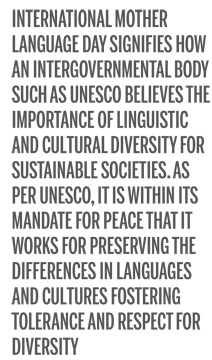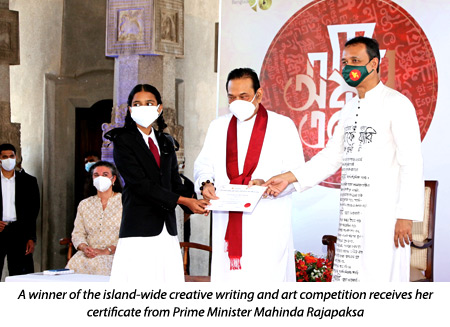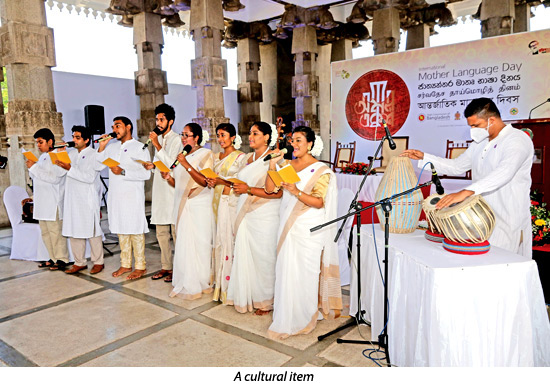
 Bangladesh High Commission, Colombo, observed International Mother Language Day (IMLD) -2022 at the Independence Square recently in the presence of Prime Minister Mahinda Rajapaksa, Education Minister Dinesh Gunawardena, Trade Minister Bandula Gunawardena, State Minister Tharaka Balasuriya, head of diplomatic missions, representatives of UN organisations and hundreds of students from different schools across the island.
Bangladesh High Commission, Colombo, observed International Mother Language Day (IMLD) -2022 at the Independence Square recently in the presence of Prime Minister Mahinda Rajapaksa, Education Minister Dinesh Gunawardena, Trade Minister Bandula Gunawardena, State Minister Tharaka Balasuriya, head of diplomatic missions, representatives of UN organisations and hundreds of students from different schools across the island.
The theme of this year’s celebration was “Mother-Mother Language- Motherland”. The observance was arranged in partnership with the Ministry of Education of Sri Lanka with support of UN Offices in Colombo and Scouts Association of Sri Lanka.
High Commissioner of Bangladesh Tareq Md Ariful Islam narrated Bangladesh’s lead role in UNESCO’s proclamation of the International Mother Language Day and shared the Day’s historical perspective. Sri Lanka’s Education and Trade Ministers and the UN Resident Coordinator spoke about the importance of preservation and protection of mother tongues and significance of multilingualism.
Theme
The theme of International Mother Language Day 2022 is “Using technology for multilingual learning: Challenges and opportunities”. The theme raises potential role of technology in advancing multilingual education and support development of quality learning and teaching for all.
History

International Mother Language Day was an initiative of Bangladesh. It was later approved at the 1999 UNESCO General Conference. Since then, it has been celebrated annually. The first International Mother Language Day was observed in 2000. This day was first announced by UNESCO on November 17, 1999. In 2002, it was formally recognised by the United Nations General Assembly.
Significance
International Mother Language Day signifies how an inter-governmental body such as UNESCO believes the importance of linguistic and cultural diversity for sustainable societies. As per UNESCO, it is within its mandate for peace that it works for preserving the differences in languages and cultures fostering tolerance and respect for diversity. The day is significant for raising awareness on native languages because, linguistic diversity is coming under threat as more languages are disappearing. As per UN reports, 40 percent of the population worldwide does not have access to education in a language they understand or speak.
This creative initiative of the High Commission was also appreciated by the dignitaries. On this occasion, with the assistance of Sri Lanka’s Ministry of Education, an island-wide creative writing and art competition for children was conducted.
Technology for distance learning
Fifteen winners received their awards and certificates from the Prime Minister and other dignitaries. Through this competition, the children of Sri Lanka have got the opportunity to know about the significance of International Mother Language Day, the importance of preserving mother tongue and the history of Bangladesh’s Language Movement.
Covid-19 has highlighted the importance of technology for distance learning. As a result, UN recognises that technology can potentially address some of the greatest challenges in education. The theme of year 2022 stresses on how mother tongue based multilingual education is a key component of inclusion in education.
A recent UNESCO, UNICEF, World Bank and OECD survey on national education responses to Covid-19 school closures of 143 countries showed that 96 percent of high-income countries provided remote learning through online platforms for at least one education level compared to only 58 percent of low-income countries. In low-income contexts, the majority of countries reported using broadcast media such as television (83 percent) and radio (85 percent) to support continuity of learning.

Teachers lacked skills and readiness for using distance teaching. Many learners lacked equipment, internet access, accessible materials, adapted content, and human support that would have allowed them to follow distance learning. Moreover, distance teaching and learning tools, programs and content are not always able to reflect language diversity.
The day’s attraction was an enthralling multilingual cultural performance by students and performers of Russia House in Colombo, SAARC Cultural Centre, Maldivian Educational and Cultural Centre, Swami Vivekananda Cultural Centre, Alliance Française, Bangladesh High Commission in Colombo and singers from Sri Lanka.
Cultural performance
 Their performance represented quintessentially their cultural tradition and the love for mother tongue in the forms of song, dance, and recitation. The highlight of the cultural event was the choral rendition of the immortal Ekushey song – paying tribute to the Language Martyrs, by the children of the High Commission officials and their family members.
Their performance represented quintessentially their cultural tradition and the love for mother tongue in the forms of song, dance, and recitation. The highlight of the cultural event was the choral rendition of the immortal Ekushey song – paying tribute to the Language Martyrs, by the children of the High Commission officials and their family members.
Dignitaries present scribbled their feelings about the day on a canvas with the strokes of brush and colour in their mother tongues. A one-minute silence was also observed at the beginning of the program in honour of the Language Martyrs.
The Day’s observance began at the High Commission Chancery with ceremonial hoisting of the national flag at half-mast followed by one-minute of silence and special prayers for the Language Martyrs and reading out messages of high dignitaries of Bangladesh.
As a part of the observance, Bangladesh High Commission and the University of Colombo jointly organised a webinar titled “Using Technology for Multilingual Learning: Challenges and Opportunities”.
A blood donation camp was also organised in association with the Sri Lanka Scouts’ Association.
